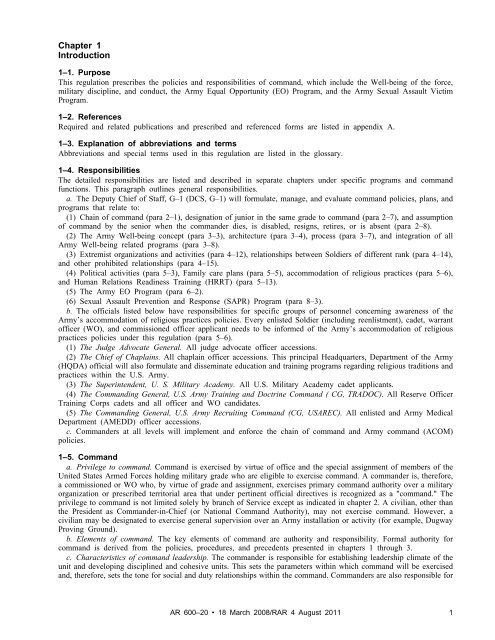AR 600-20, Army Command Policy - Army Publishing Directorate ...
AR 600-20, Army Command Policy - Army Publishing Directorate ...
AR 600-20, Army Command Policy - Army Publishing Directorate ...
Create successful ePaper yourself
Turn your PDF publications into a flip-book with our unique Google optimized e-Paper software.
Chapter 1<br />
Introduction<br />
1–1. Purpose<br />
This regulation prescribes the policies and responsibilities of command, which include the Well-being of the force,<br />
military discipline, and conduct, the <strong>Army</strong> Equal Opportunity (EO) Program, and the <strong>Army</strong> Sexual Assault Victim<br />
Program.<br />
1–2. References<br />
Required and related publications and prescribed and referenced forms are listed in appendix A.<br />
1–3. Explanation of abbreviations and terms<br />
Abbreviations and special terms used in this regulation are listed in the glossary.<br />
1–4. Responsibilities<br />
The detailed responsibilities are listed and described in separate chapters under specific programs and command<br />
functions. This paragraph outlines general responsibilities.<br />
a. The Deputy Chief of Staff, G–1 (DCS, G–1) will formulate, manage, and evaluate command policies, plans, and<br />
programs that relate to:<br />
(1) Chain of command (para 2–1), designation of junior in the same grade to command (para 2–7), and assumption<br />
of command by the senior when the commander dies, is disabled, resigns, retires, or is absent (para 2–8).<br />
(2) The <strong>Army</strong> Well-being concept (para 3–3), architecture (para 3–4), process (para 3–7), and integration of all<br />
<strong>Army</strong> Well-being related programs (para 3–8).<br />
(3) Extremist organizations and activities (para 4–12), relationships between Soldiers of different rank (para 4–14),<br />
and other prohibited relationships (para 4–15).<br />
(4) Political activities (para 5–3), Family care plans (para 5–5), accommodation of religious practices (para 5–6),<br />
and Human Relations Readiness Training (HRRT) (para 5–13).<br />
(5) The <strong>Army</strong> EO Program (para 6–2).<br />
(6) Sexual Assault Prevention and Response (SAPR) Program (para 8–3).<br />
b. The officials listed below have responsibilities for specific groups of personnel concerning awareness of the<br />
<strong>Army</strong>’s accommodation of religious practices policies. Every enlisted Soldier (including reenlistment), cadet, warrant<br />
officer (WO), and commissioned officer applicant needs to be informed of the <strong>Army</strong>’s accommodation of religious<br />
practices policies under this regulation (para 5–6).<br />
(1) The Judge Advocate General. All judge advocate officer accessions.<br />
(2) The Chief of Chaplains. All chaplain officer accessions. This principal Headquarters, Department of the <strong>Army</strong><br />
(HQDA) official will also formulate and disseminate education and training programs regarding religious traditions and<br />
practices within the U.S. <strong>Army</strong>.<br />
(3) The Superintendent, U. S. Military Academy. All U.S. Military Academy cadet applicants.<br />
(4) The <strong>Command</strong>ing General, U.S. <strong>Army</strong> Training and Doctrine <strong>Command</strong> ( CG, TRADOC). All Reserve Officer<br />
Training Corps cadets and all officer and WO candidates.<br />
(5) The <strong>Command</strong>ing General, U.S. <strong>Army</strong> Recruiting <strong>Command</strong> (CG, US<strong>AR</strong>EC). All enlisted and <strong>Army</strong> Medical<br />
Department (AMEDD) officer accessions.<br />
c. <strong>Command</strong>ers at all levels will implement and enforce the chain of command and <strong>Army</strong> command (ACOM)<br />
policies.<br />
1–5. <strong>Command</strong><br />
a. Privilege to command. <strong>Command</strong> is exercised by virtue of office and the special assignment of members of the<br />
United States Armed Forces holding military grade who are eligible to exercise command. A commander is, therefore,<br />
a commissioned or WO who, by virtue of grade and assignment, exercises primary command authority over a military<br />
organization or prescribed territorial area that under pertinent official directives is recognized as a "command." The<br />
privilege to command is not limited solely by branch of Service except as indicated in chapter 2. A civilian, other than<br />
the President as <strong>Command</strong>er-in-Chief (or National <strong>Command</strong> Authority), may not exercise command. However, a<br />
civilian may be designated to exercise general supervision over an <strong>Army</strong> installation or activity (for example, Dugway<br />
Proving Ground).<br />
b. Elements of command. The key elements of command are authority and responsibility. Formal authority for<br />
command is derived from the policies, procedures, and precedents presented in chapters 1 through 3.<br />
c. Characteristics of command leadership. The commander is responsible for establishing leadership climate of the<br />
unit and developing disciplined and cohesive units. This sets the parameters within which command will be exercised<br />
and, therefore, sets the tone for social and duty relationships within the command. <strong>Command</strong>ers are also responsible for<br />
<strong>AR</strong> <strong>600</strong>–<strong>20</strong> 18 March <strong>20</strong>08/R<strong>AR</strong> 4 August <strong>20</strong>11<br />
1
















